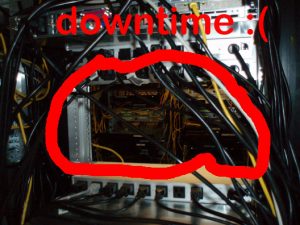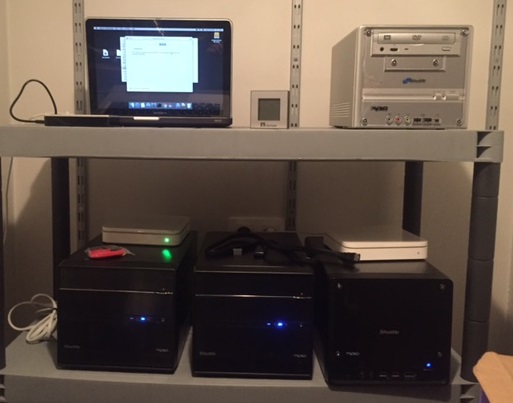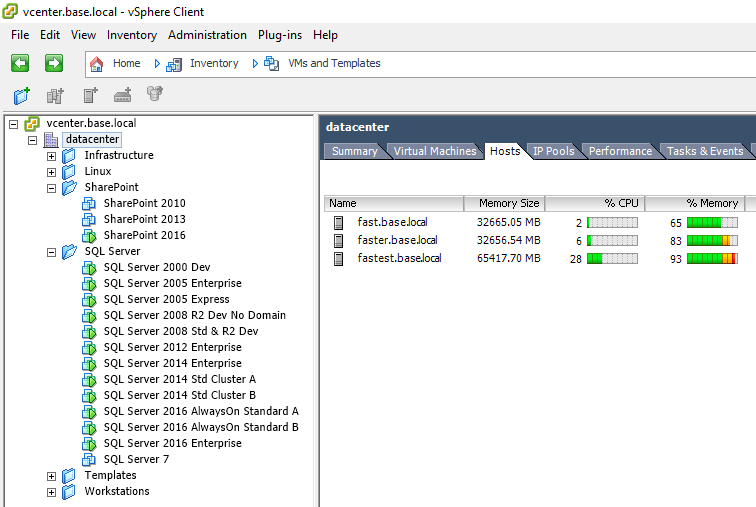My homelab
My first homelab ever was started as a single Packard Bell 486 which ran SuSE Linux 5.2. I used it with my @Home connection to host web, DNS and mail services. Over time, I'd move leftover computers to a data center and covered most of my colo fees with the proceeds from Google Adsense, which I added to my website RealCajunRecipes.com back in 2004.
I had a whole mixed domain (Windows and Linux) in my quarter rack located in downtown Los Angeles. I'd moved a few times and always brought my homelab (which now consisted of HP DL360s) with me which meant tons of downtime.
After moving my servers from LA to San Jose to Austin, I opted for hosting my websites on a VPS, and kept my homelab... at home. And with that, gone were the days of impressing ladies by showing them the Internet.
My homelab
Nowadays, I have super lightweight, quiet, and fast Shuttles. Here's what my lab looks like from SUPA FAST to decently fast.
Storage and performance
Yes, it's true, I have no redundancy. Sucks but I love local storage, don't have enough room for more disks and my janky backups work well enough.
I had a WD Green 1TB in there for a few days and did some tests; here's how the benchmarks fared. In order: Western Digital 1TB Green Drive, Samsung 850 EVO 500GB, and Samsung 950 PRO 512GB M.2.
That's virtualized, too! These tests were performed on my SH170R6 box with ESX and a Win10 VM with regular ol attached disks. I'm so impressed by not only M.2 but ESX as well.
For any of you following some of the work I do with SQL Server and PowerShell import performance, I was disappointed to see that the M.2 only increased the imports by about 20,000 rows per second. That suggests that a majority of the tuning I've got left to do is in Windows, SQL Server and on the network.
Network
I love client side networking like VPNs and stuff, but I'm not a fan of networking in general so I keep it simple. I use Apple Airport Extremes - one in the living room that connects to the Internet and one in the storage closet that connects to the one in the living room via wireless. It's *so* fast, even though 1 Belgian concrete wall and 2 large rooms. Speedtest.net just said that I got 106.52 Mbps down, 10.49 Mbps up. Through a wall and over 2 rooms of wireless!
The communication between all of my VMs stay local, though, which is cool. I also have an older Cisco router but networking ain't my bag so it's waiting for the day that I'm interested. When I need anything more than the basics, I use a WRT54GL with dd-wrt.
Why not just use Azure?
I like to test my scripts against a variety of versions/editions and I don't like spinning VMs up and down all the time. As for the cost; some people spend their money on golf, Polish pottery and gaming rigs. I spend mine on servers, Belgian beer and travel ;)
As you can see, I also have an old Macbook Pro with 256 SSD, 4TB HDD and 8GB RAM in the mix. It's for photos and videos, however. And someone gave me an old silver Shuttle from like 2002, but I haven't had the time to set it up yet.
So what runs on this?
I started using VMware products around 1999 and continue to use it to this day for virtualization. Currently, I'm running vSphere 6. I get a super cheap license through my school, Regis University, though you can also get it for $200/year if you become a member of VMUG.
Thanks to my MSDN account, I also have a whole mix of SQL Servers, some DCs, Remote Desktop Gateway, Lync, SharePoint, Exchange, FreeNAS, docker, some rando test servers, and then a few different workstations like Windows 7 with PowerShell 3 and SQL Server 2008 R2 SMO to ensure dbatools works on older systems.
The rest of my equipment is Apple (big ol Thunderbolt display, Mac Mini, Macbook Pro), which is use to RDP to my Windows and Linux machines.
Anyway, that's my homelab. It's lightweight which is necessary because I broke my shoulders back in 2007 and can't carry heavy things. It's also energy efficient, which is necessary because I live in Europe where the energy prices are crazy.
Hope you enjoyed!




